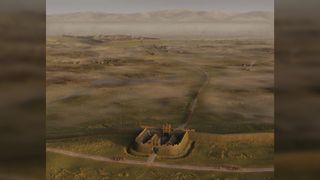'Lost' 2nd-century Roman fort discovered in Scotland
Archaeologists have discovered the buried remains of a Roman fort along Scotland's ancient Antonine Wall.

Archaeologists have discovered the foundations of a "lost" second-century Roman fort in western Scotland — part of an ill-fated effort to extend the empire's control throughout Britain.
The fort was one of up to 41 defensive structures built along the Antonine Wall — a fortification of mainly earthworks and wood that ran for about 40 miles (65 kilometers) across Scotland at its narrowest point, according to Historic Environment Scotland (opens in new tab) (HES), a government agency.
The Roman emperor Antoninus Pius ordered the wall built in A.D. 142 in hopes of surpassing his predecessor Hadrian, who about 20 years earlier had built the fortification known as Hadrian's Wall about 100 miles (160 km) to the south.
But his push was ultimately unsuccessful, in part because of the hostility of the Indigenous people. (At this time the Romans called them "Caledonians"; later they would call them "Picts," from a Latin word meaning "painted people," because of their body paintings or tattoos.) After 20 years trying to hold their new northern line, the Romans abandoned the Antonine Wall in A.D. 162 and retreated back to Hadrian's Wall.

"Antoninus Pius was effectively a bureaucrat," historian and archaeologist John Reid (opens in new tab) told Live Science. "He had no military experience, and we think he was looking for a win that he could pretty much guarantee against the exotic Caledonian people."
Related: Ancient Romans painted horrifying blood-red warnings on wall across Scotland
Reid explained that Roman emperors needed to claim a military victory, and so Antoninus Pius used his conquest of Scotland — while it lasted — to justify his rule.
Reid, who was not involved in the new discovery, is author of the book "The Eagle and the Bear: A New History of Roman Scotland" (opens in new tab) (Birlinn, 2023) and chairman of the Trimontium Trust (opens in new tab), which investigates Roman archaeology in the Scottish Borders region.
"Lost" fort
Archaeologists from HES found the buried remains of the small fort, or "fortlet," beside a school on the northwestern outskirts of the modern city of Glasgow.
The structure was mentioned by an antiquarian in 1707, but it had never been found since, despite efforts to locate it in the 1970s and 1980s.
The fort consisted of two small wooden buildings surrounded by a rampart of stone and turf up to 6.5 feet (2 meters) high, built along the south side of the Antonine Wall. The rampart had two wooden towers above gates on opposite sides — one at the north to let people, animals and wagons through the wall and one at the south.

But there's now nothing above ground to show that the fort was ever there; , and the archaeologists located its buried stone foundations using gradiometry, a noninvasive geophysical technique that measures tiny variations in Earth's magnetic field to detect underground structures.
About 12 soldiers — many of them local auxiliaries, or "auxilia," who had signed on to fight for the Romans — would have been stationed at the fort for about a week at a time to keep watch over the area and prevent raids on the fortifications.
They'd then be relieved by a new detachment of soldiers from a larger Roman fort at Duntocher, about a mile (1.6 km) to the east, according to the HES statement.
Roman wall

There's now little visible evidence of the Antonine Wall, and the newly discovered fortlet is a rare find.
Reid said it helped confirm a theory that the Romans first hoped to duplicate Hadrian's Wall, with stronger and higher fortifications made of stone and a small fort, or "milecastle," every mile of its length. "But then they thought better of it and decided they needed proper-sized forts," he said.
Roman fortifications in the Tayside region, north of the Antonine Wall, showed that the Romans planned to subjugate all of Scotland, but the Antonine Wall and any northern possessions seem to have been abandoned after A.D. 162, he said.
Thereafter, Hadrian's Wall became the northernmost frontier of the empire, seemingly until Roman rule collapsed in Britain in the early fifth century, he said.
Reid's Trimontium Trust has conducted excavations at Burnswark Hill, the site of a Caledonian hillfort and a fortified Roman military camp built to attack it after Antoninus Pius ordered his legions to conquer Scotland north of Hadrian's Wall. Among the finds there were whistling sling bullets that the Romans may have used as "terror weapons" against the defenders.
The reason for the Roman eventual withdrawal from the Antonine Wall and back to Hadrian's Wall is not well understood.
"There's lots of debate," Reid said. "Was it because the Romans got fed up? Was it because the Romans had trouble elsewhere? Was it because it was too costly to run two frontiers? Was it because Antonius Pius died [in A.D. 161]? Nobody's really sure; I suspect it was a combination of all of those."
Live Science newsletter
Stay up to date on the latest science news by signing up for our Essentials newsletter.
Tom Metcalfe is a freelance journalist and regular Live Science contributor who is based in London in the United Kingdom. Tom writes mainly about science, space, archaeology, the Earth and the oceans. He has also written for the BBC, NBC News, National Geographic, Scientific American, Air & Space, and many others.
Most Popular

By Ben Turner

By Jamie Carter

By Sascha Pare